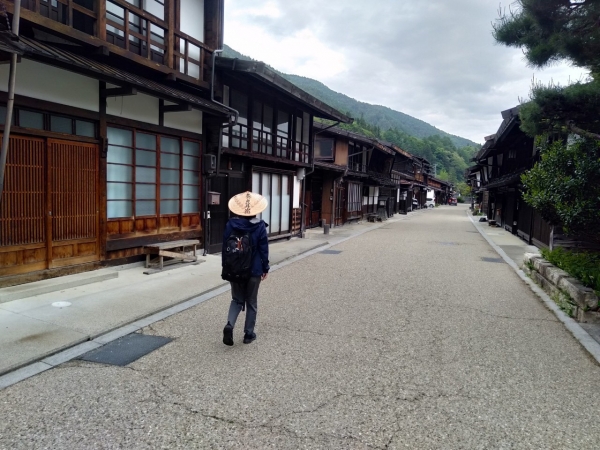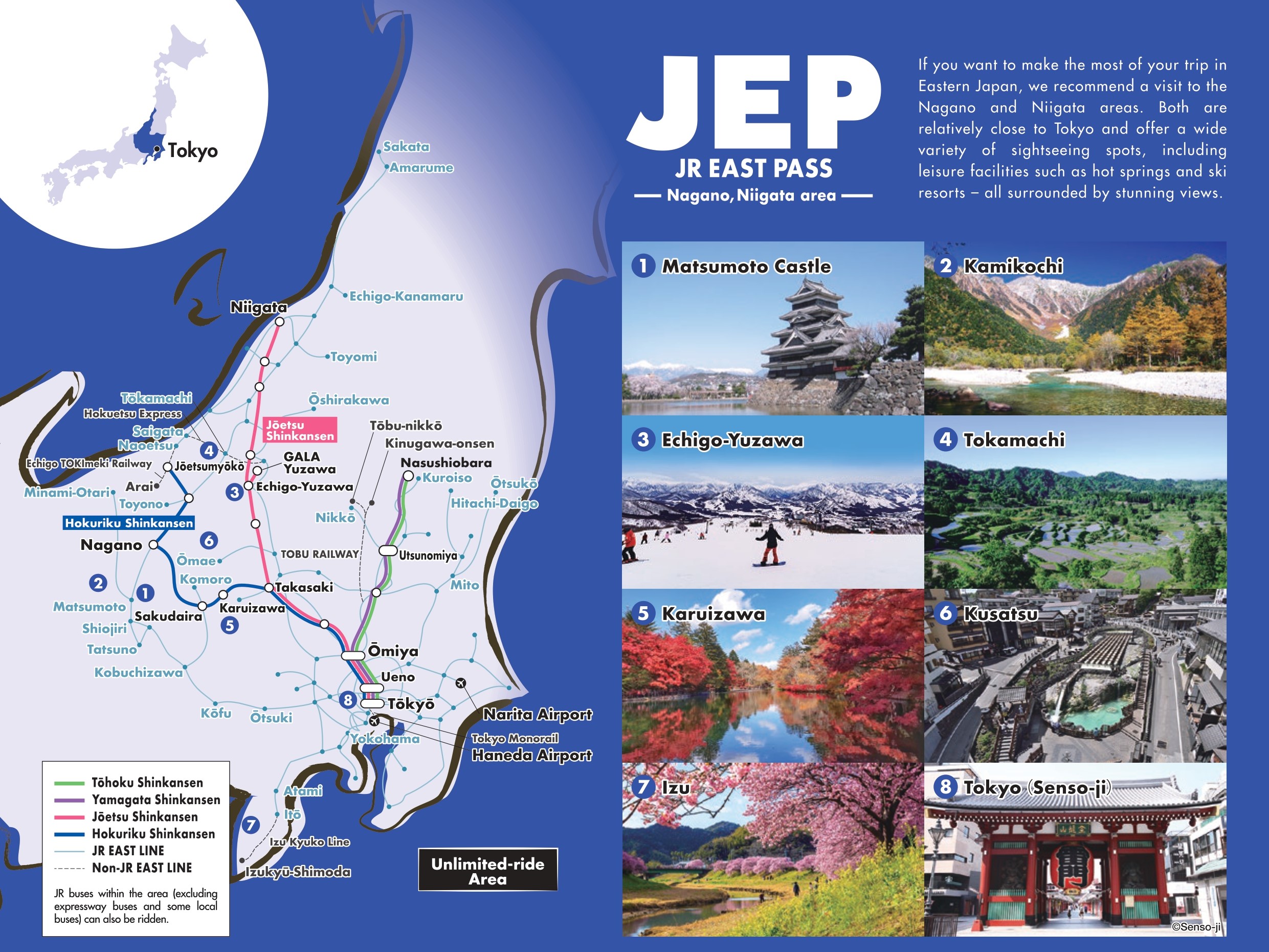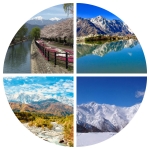Shiojiri, the centre of Nagano: Enjoy history, nature and wine!

Hi! I’m Chie from JR East Nagano Branch. I live in Matsumoto City (松本市 Matsumoto-shi), which is famous for Matsumoto Castle. When you visit Japan, I hope that you will not only visit Matsumoto, but also the other cities around it. I didn’t know much about Matsumoto’s neighbouring city, Shiojiri (塩尻), so I went to explore it this time.
Where is Shiojiri City?

Map of Shiojiri’s location in Nagano Prefecture (left) and the Nakasendo and Tokaido roads (right). (Image credit: JR East / Chie Matsubara)
Shiojiri City is located at almost exactly the centre of Nagano Prefecture (長野県 Nagano-ken). This means that it is practically the geographical centre of Japan, and thus has long been important as a strategic traffic point. Going back to the Edo Period (1603–1868), there were five main highways in Japan, and because of sankinkōtai (参勤交代), roads and post stations (宿場 shukuba) were maintained. Sankinkotai was a policy by the Tokugawa shogunate where feudal lords (大名 daimyō) were required to live alternately between their domain and Edo, the capital. These frequent moves meant that they often passed through main roads.
One of these main roads was Nakasendō (中山道), which linked Tokyo with Kyoto. Another road which linked Tokyo with Kyoto was Tokaidō (東海道). Compared to Tokaido, Nakasendo was cooler because of its location in the mountains. There are no seas or large rivers like Oigawa (大井川) in Nakasendo, so people would rarely get stuck due to seasickness or flooding. For these reasons, Nakasendo was used as the bridal road of princesses in the past.
We can still enjoy historical views of the city at many post towns along Nakasendo, which were used as resting places by travellers in the past. Naraijuku (奈良井宿) is one of the post stations on Nakasendo, and is located in Shiojiri City.
Experience history and culture by walking through the post town

Walking down Naraijuku. (Image Credit: JR East / Chie Matsubara)
Even though I have been living in Nagano for a long time, I have never explored Naraijuku, so this time I walked from one end to the other, and was surprised by the length of it. It is said that Naraijuku is the longest post station in Japan. Beautiful historical views of the city continued for 1km – it was beautiful everywhere.
I would like to introduce three places along the street. The first is Chōsenji (長泉寺), which is a temple along Naraijuku.

Chosenji’s dragon painting. (Image credit: JR East / Chie Matsubara)
There were many temples at Naraijuku. As soon as I entered to the Hondō (本堂 main hall), a huge painting of a dragon on the ceiling caught my eyes. It was painted in the Meiji Era (1868–1912). The dragon’s eyes were painted with a special process, which makes it look as if it is drawing me in. Before, there used to be special sound made when you clapped your hands under the dragon, but because of deterioration we can’t hear the sound anymore.

Chosenji’s exterior (Image credit: JR East / Chie Matsubara)
Also, there were bamboo crates used in the Edo era on display at Chosenji. These were what people of the past used to transport on the Nakasendo. They were bigger than I thought. If you ask the temple beforehand, they will open up the Hondo.
The second place I would like to introduce is Gallery Pausa di Chroma (ギャラリィ パウザ・ディ・クローマ).

Floral accessories at Gallery Pausa di Chroma. (Image credit: JR East / Chie Matsubara)
The quaint door, tatami and garden caught my eye. Here there were accessories of real flowers and plants made with a special process on sale. The flowers and plants of each season are made into accessories so that you can preserve and wear their beautiful colours forever. The flowers are not artificially coloured; their natural colours are already so beautiful.
Third, I would like to introduce zakka (雑貨 miscellaneous goods) at Kogetsudō (湖月堂).


Inside Kogetsudo. (Image credit: JR East / Chie Matsubara)
The moss ball (苔玉 kokedama) and pottery caught my eye, so I entered the store. There were so many old knick-knacks and the store had a perfect atmosphere. There were things I had never seen or used before, but they brought back memories, and they were so lovely.
Naraijuku is beautiful not only when looking at it from the outside, but even more so when entering and feeling the beauty of historical Japan.
Enjoy a superb view while hiking and healing with nature

Going hiking. (Image credit: JR East / Chie Matsubara)
The post town next to Naraijuku is Yabuharajuku (薮原宿). Do you know how people in olden times walked between them? They crossed a mountain pass by foot or with horses. This mountain pass is called the Torii Pass (鳥居峠 Torii Tōge), and nowadays it is known as a hiking course.
I love hiking, so I just had to visit this course. After asking the staff at the tourism office, they said that passing the Torii Pass from Yabuhara Station (藪原駅) to Narai Station (奈良井駅) is easier than from Narai Station to Yabuhara Station. Thus, I started from Yabuhara Station.

Yabuhara Station. (Image credit: JR East / Chie Matsubara)
① I got off the train at Yabuhara station. There is nothing around the station, so just follow the map and head north.

Building along the way. (Image credit: JR East / Chie Matsubara)
② Go under the railroad track to reach Yabuharajuku. I saw some nice buildings along the way, and stopped by for a visit. They lent us bear-repelling bells and cypress hats (桧笠 hinoki gasa), which could be used to block the rain or as a sunshade.

Renting a cypress hat. (Image credit: JR East / Chie Matsubara)
These cypress hats have been a traditional craft of the Kiso Area since the Edo Period. They are available for rental, and you can get the deposit back when you return items at any of the three Tourist Information Centers (観光案内所 kankō annai sho).

Cobblestone path. (Image credit: JR East / Chie Matsubara)
③ Go uphill between private houses, and you will reach a beautiful green mountain pass. Just when I thought I felt a bit tired, I became refreshed after seeing the cobblestone path. My thoughts wandered to the people who made these beautiful paths as I walked along step by step.

View of Yabuharajuku (left) and beautiful green trees (right). (Image credit: JR East / Chie Matsubara)
④ After that, the twisting and turning uphill path continued. I felt out of breath, but the scenery of Yabuharajuku and the beautiful green trees made me enjoy walking.

Horse chestnut trees in summer. (Image credit: JR East / Chie Matsubara)

Horse chestnut trees in autumn. (Image credit: Shiojiri City Tourist Association)
⑤ At the end of the uphill climb, the mountain pass became flat and large horse chestnut trees (トチノキ tochi-no-ki) welcomed me. The horse chestnut trees gave me energy. Also, the drifting scent of the trees and flowers made me feel truly surrounded by nature.

Signs to Naraijuku. (Image credit: JR East / Chie Matsubara)
⑥ The sign changed from “→Torii Pass” to “→Naraijuku”. I concentrated on walking downhill towards Naraijuku. The views of small rivers, flowers and cobblestone paths made me feel relaxed again.
It is said that the Torii Pass has the highest elevation and is the hardest to pass of the 11 post stations in Kiso along Nakasendo. People of the past did not have good shoes, and their baggage was heavy, so I can’t imagine how hard it was for them to traverse the pass with their conditions! A lot of time has passed, but I think this is a part of history that we can enjoy while passing this area as a hiking course.
We were informed that it is alright to hike with sneakers, so I didn’t wear climbing shoes, and wore sneakers instead. Although there were some slippery downhill slopes with small stones and sand, I could safely pass through them with no problems.

Tourist Information Center at Naraijuku. (Image credit: JR East / Chie Matsubara)
The next day, I didn’t have any muscle pains. Torii Pass has become my No.1 hiking course in Nagano where I can enjoy both nature and history while exercising. It’s one of my favourite spots!
Don’t forget to return the bear-repelling bells and cypress hats to the Tourist Information Center after hiking! If you visit Naraijuku, or if you like hiking, why don’t you pass by the Torii pass?
Taste local food and drink

Enjoying sanzokuyaki for lunch. (Image credit: JR East / Chie Matsubara)
I became hungry after walking a lot, so I had lunch after arriving at Shiojiri Station. I wanted to eat local cuisine sanzokuyaki (山賊焼), which originated in Shiojiri and Matsumoto, the centres of Nagano. Sanzokuyaki is a big piece of deep-fried chicken marinated in soy sauce with garlic, ginger, and other spices.

Hottoshitezawa. (Image credit: JR East / Chie Matsubara)
Usually, I order it when I have drinking parties (飲み会 nomikai) at izakaya (居酒屋 Japanese pubs) because it goes well with beer, but this time I wanted to enjoy it for lunch. I went to Hottoshitezawa (ほっとしてざわ), the nearest restaurant at Shiojiri Station. It is just down the stairs at by the East Exit (東口 higashi-guchi).

View of the train platforms from the restaurant. (Image credit: JR East / Chie Matsubara)
There are Japanese-style seats at the very back of the restaurant. The restaurant has a good atmosphere and you can also see trains because it is located next to the platforms.

Sanzokuyaki teishoku. (Image credit: JR East / Chie Matsubara)
I ordered the sanzokuyaku teishoku (山賊焼定食 sanzokuyaki set meal). After it arrived, my impression was “This is so Sanzokuyaki!” The outside was crispy, and the inside was really soaked in soy sauce.
Talking about Japanese teishoku (定食set meals), this one came with rice, miso soup, and pickles, which make a good combination with sanzokuyaki.

Handmade soba. (Image credit: JR East / Chie Matsubara)
The restaurant has tasty handmade soba too, which I also recommend. Please try the texture and flavour of handmade soba!
After lunch, I wanted to explore Shiojiri more. Shiojiri is famous for wine. Sanzokuyaki is famous in both Shiojiri and Matsumoto, but wine is a specialty of only Shiojiri. As a train driver, when I drive the trains I notice that Shiojiri is cooler than Matsumoto in summer, and Shiojiri has much more snow in winter. Maybe these differences are the reason why grapes can grow only in Shiojiri.
There is one specialty at each of the stations of JR East’s Nagano Branch Office, and Shiojiri Station’s specialty is a vineyard on the platform, featuring real grapes. Thanks to the meticulous tending by local people, we can see them bear fruit every autumn.

Vineyard at the platform. (Image credit: JR East / Chie Matsubara)
Don’t you think that Shiojiri Station, where they have a vineyard, is so cool? Usually, people enjoy taking photos of trains and the station name signboard at platforms. At Shiojiri Station, you can take a photo like this too.

Bus to the wineries. (Image credit: JR East / Chie Matsubara)
There are many wineries in Shiojiri. You can visit them by local buses which have a grape mascot marked on them. Services are suspended on Sundays, public holidays, and from 30 December – 3 January.

Sinano Wine. (Image credit: JR East / Chie Matsubara)
I visited Sinano Wine (信濃ワイン Shinano wain) by local bus this time; it is a 5-minute walk from Nakahara bus stop.

Vineyard at Sinano Wine. (Image credit: JR East / Chie Matsubara)
I asked them beforehand, and they showed me around the vineyard too. This used to be a rice field. Now it is a vineyard where they grow grapes with weeds. This means that they don’t pull weeds, and the dead weeds become organic fertilisers. After growing to a certain extent, the vines undergo pruning (芽かき mekaki), and the remaining vines receive a good amount of sunlight and are kept breezy.
Even though the winery has seven to eight areas for growing grapes, there are only two people taking care of them. I understand the efficiency and how they put their heart and soul into growing the grapes.

Sinano Wine’s underground wine cellar. (Image credit: JR East / Chie Matsubara)
I also viewed their underground wine cellar. Once I opened the door to the underground cellar, the good scent of fermented grapes filled the air. I wish I could let you experience this scent. Once I entered the cellar, there was also the sound of classical music. The wines rest with classical music.

Sinano Wine’s underground wine cellar. (Image credit: JR East / Chie Matsubara)
To my surprise, the temperature in the cellar was really cool. The cellar is not only located underground, but it is also surrounded by groundwater and little stones. Thanks to these coincidences, the cellar can be kept cooler without any air-conditioning. No temperature change, no sunlight and 60-80% humidity are important to be able to keep wines longer.

Wines on sale. (Image credit: JR East / Chie Matsubara)
An interesting thing that I heard from the company president was that wine tastes like the place and climate where it was grown. Niagara and Concord are common variety of grapes in Shiojiri, so I bought back Niagara, a white wine, as a souvenir. The flavour was a bit strong, but after put in my mouth, it became mellow and soft. I enjoy Shiojiri wine because I feel it with my five senses.
After getting back to the station, I visited a souvenir shop near the Tourist Information Center and found a small-sized wine with a cup. In Japan, people enjoy drinking alcohol on trains. Why don’t you try and enjoy drinking wine on trains?
Access by train and comfortable bus tour
By train
- Shiojiri Station (塩尻駅): Approximately 2 hours 40 minutes by limited express Azusa on the JR Chūō Line (中央線) from Shinjuku Station (新宿駅); or 15 minutes by local train on the Shinonoi Line (篠ノ井線) from Matsumoto Station (松本駅); or 1 hour by limited express Shinano from Nagano Station (長野駅).
- Yabuhara Station(藪原駅): Approximately 30 minutes by local train on the Chūō West Line (中央西線) from Shiojiri Station (塩尻駅).
- Narai Station (奈良井駅): Approximately 25 minutes by local train on the Chūō West Line from Shiojiri Station.

Bus tour pamphlet. (Page 1 | Page 2) (Image credit: JR East)
By bus tour
- Sightseeing bus
There is a special bus tour departing from Matsumoto Station or Shiojiri Station that will take you to some of the places that I shared in this article. Please choose a tour (Tour 1: Walking in Naraijuku: the Nakasendo and Kisoji Routes; Tours 2, 3: Trekking the Torii Pass) and make a reservation online, or you can buy same-day ticket if there are vacant seats. For more information, visit this page.
(Note: Due to the ongoing coronavirus situation, ticket sales for the sightseeing bus tour have been suspended until further notice. Please check the tour page for updated information.)
JR EAST PASS (Nagano, Niigata area)

The new JR EAST PASS (Nagano, Niigata area) and usage area. (Image credit: JR East)
If you are thinking of visiting Shiojiri City or visiting the rest of Nagano Prefecture, check out the JR EAST PASS (Nagano, Niigata area), an affordable pass offering unlimited rail travel on JR East lines (including bullet trains) in the area for 5 consecutive days at only ¥27,000.
JR EAST Welcome Center MATSUMOTO

JR EAST Welcome Center MATSUMOTO. (Image credit: JR East / Chie Matsubara)
If you visit Nagano, please come to JR EAST Welcome Center MATSUMOTO, a counter exclusively for foreign tourists. It is located just in front of the ticket gate of JR Matsumoto Station. We will support your trip through the exchange or purchase of the JR EAST PASS, selling tickets and tourist information.
Header image credit: JR East / Chie Matsubara
Related Articles
- Queen of the Northern Alps: Mount Tsubakuro!
- Reaching for the stars: HIGH RAIL 1375
- Solo hiking from Kamikochi to Karasawa: A jewel in autumn
Writer's profile:
Chie Matsubara
Chie lives in Nagano, Japan, where the four seasons have a stark contrast from one another compared to other prefectures. As a train driver, Chie can drive trains, but she's not good at driving cars, so she enjoys travelling by public transportation. Chie wants to share information on Nagano from the same perspective as tourists.




